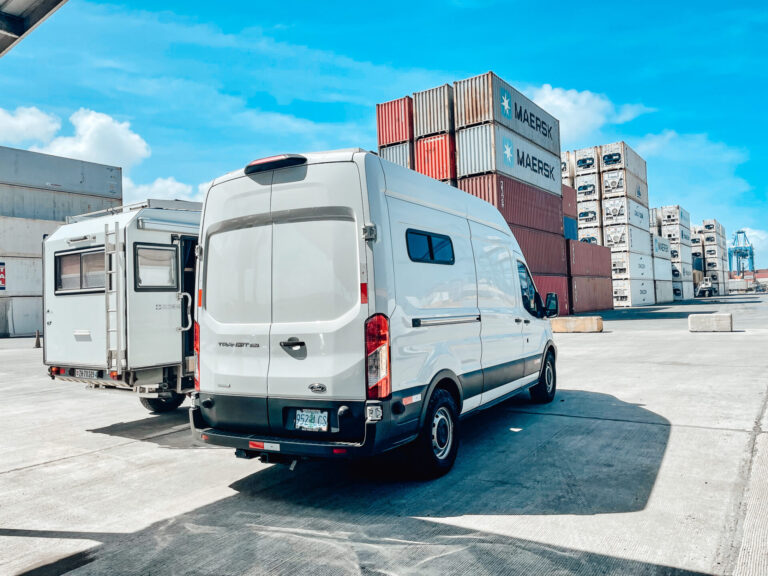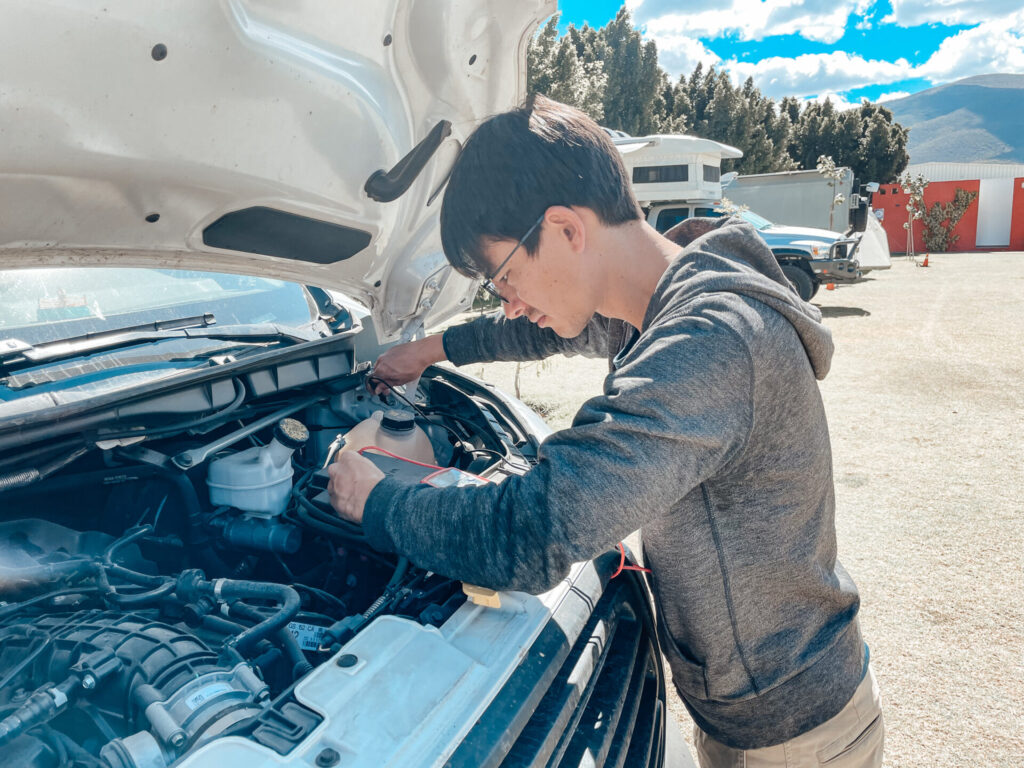
As the summer season winds down, many of us are starting to think about best practices to follow before placing our RVs in long-term storage. It would be temptingly easy to just park the vehicle, turn off the ignition, and simply leave the RV at the storage facility, but doing so without taking proper precautions promotes damage and degradation to your beloved travel home.
In this article, we provide 8 tips of what you can do to help ensure your RV is safely packed, stored, and ready for your next adventures the following season.
If you’re ready, let’s get to it!
1. Clean RV Thoroughly Before Storage
Properly packing up and cleaning an RV before storing the vehicle helps to minimize the intrusion of unwanted pests (think rats, roaches, and ants!) and mold growth. Trust us from experience, once you have a mold problem, it’s quite an effort to get rid of it!
We recommend starting by removing all foods from your vehicle and wiping all surfaces with an alcoholic wipe. Lastly, sweep the floor just before you exit the RV to get rid of any trace amounts of food, dirt, and dust. Doing this can also help to reduce the amount of bad odors that can accumulate in the RV over time.

Additional Tip: If you have access to a shore power plug, keeping a small dehumidifier plugged into your RV can do wonders to reduce interior humidity.
2. Drain Water From Water Tanks & Pipes
To keep water tanks and pipes clean and functioning properly it’s imperative to drain and empty them. Stagnant fluids can deteriorate over time and become a breeding ground for bacteria and fungi. Additionally, if the RV will be stored in a climate that experiences sub-freezing temperatures, draining the water prevents the tanks and pipes from freezing and cracking.
When we store our camper van, we’ll run our faucet until we can get as much water out of our pipes as possible. Then, we disconnect the water tank and pour out any remaining liquid.
3. Disconnect Auxiliary Battery
Small, parasitic power draw is one of the leading factors that cause auxiliary/leisure batteries to die prematurely. Parasitic power draws can come in the form of any battery monitors, small LED lights, and charge controllers that are still connected to the batteries and that require a trace amount of power to function.

Did you know? Draining both AGM and lithium batteries down to 0% can significantly shorten their lifespans?
To prevent this slow, but consistent battery discharge, we recommend locating your RV’s battery switch and turning it to the off setting to disconnect the battery from all the loads. Doing this will save you time, hassle, and money by not having to buy new batteries when you’re ready to start your RV travels again the following year.
Not sure where your battery switch is? Check out our RV electrical wiring diagrams to help you locate your switch, or to help you install a battery switch if you need one.
4. Spray Chassis With Water
Over the course of a travel season, an RV’s chassis can get dirty with dirt, mud, and salt. Leaving this gunk caked on your chassis helps to promote rust buildup, which can become a real problem down the road and be costly to repair. That’s why we recommend hosing down the chassis to clean off any debris. With the right spray nozzle, this can be a quick and easy way to keep your chassis clean.
5. Protect Tires With Covers
Covering the tires during long-term storage is essential because it helps to protect them from damage caused by the elements, such as exposure to UV sunlight, rain, and extreme temperatures. If your RV is stored outside and without tire covers, you run the risk of the tire’s rubber material deteriorating and cracking over time. Tire covers are cheap (~$33) and considering our tires cost ~$220 each, picking up a set of covers is a no brainer!

Additional Tip: Make sure you have the proper amount of air pressure in each of your RV’s tires. Under-inflated tires tend to form flat spots during long-term storage and this can ruin your tires. When storing our camper van, we like to inflate our tires right up to the recommended maximum PSI to prevent the formation of flat spots.
6. Fill Gas Tank & Add Fuel Stabilizer
If you plan to store your RV for over a year, we recommend filling the gas tank and adding a fuel stabilizer. Filling the tank to full reduces the amount of air inside the tank, which reduces condensation and reduces corrosion and rust buildup in the tank.
Modern gas and diesel will oxidize and break down over time and this can have a detrimental effect by clogging fuel lines, injectors, and carburetors. Fuel stabilizers prevent this breakdown and protect all the internal components that come into contact with your fuel.
7. Consider Installing RV Skirting
If you plan to store your RV outside, adding skirting around the vehicle is an important long-term storage tip. Installing skirting helps to maintain a consistent interior temperature both under the vehicle’s chassis and inside the RV. This helps to maintain the integrity of the RV’s underbody and prevent debris and dust from accumulating and causing damage.
But just as important, skitting also creates a physical barrier to prevent pests and rodents from entering the RV through the underside. We certainly wouldn’t want any rats making themselves at home inside our camper van or engine while we’re away!
8. Use A Trickle Charger
In tip #3, we talked about the importance of disconnecting the auxiliary batteries to prevent parasitic draws from completely discharging the batteries and reducing their lifespan. The same is true for your RV’s starter battery. When left unattended, a starter battery will lose 3-5% of charge each month. This can add up if you plan to store the RV for longer than a year. When a starter battery discharges too much, it experiences sulfation and degradation in the electrodes, which damages the batteries ability to hold and maintain a charge.
If you have access to shore power, we recommend using a trickle charger to keep the starter battery topped up at 100% for the duration of the storage. This kind of charger uses only a small amount of power but is effective in preventing battery degradation.

Final Thoughts
Preparing your RV for long-term storage is essential to ensure the safety and longevity of your vehicle. The two most important reasons to be thorough with your RV storage strategy is to ensure that you have a functioning RV for the next season and to reduce the chance of costly repairs. Your RV is your home, and it deserves your time and attention to keep it healthy!
If you have any storage questions, please feel free to contact us at the email address below.
Happy traveling!
How To Contact Us
For more campervan living & building tips, check out our blog: www.asobolife.com.
Or for more on our current Pan-American road trip to Argentina visit us on Instagram: @asobolife.
Read more from AsoboLife:
Top RV Honeymoon Destinations for Summer with AsoboLife
Five Destinations To Visit With An RV In Southern Mexico with AsoboLife
